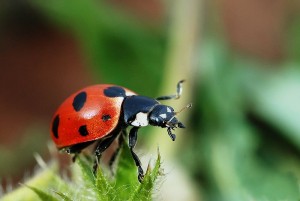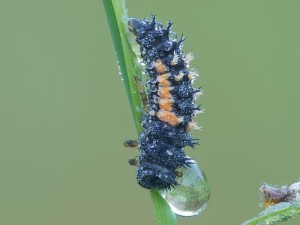Bt Toxin Kills Ladybug Larvae
 The ladybird beetle is at risk from widespread use of the Bt (Bacillus thuringiensis) toxin, a pesticide genetically engineered into corn to kill the corn borer. Although unintended, a side effect of planting the Bt corn is the increased mortality of the larvae of the ladybird beetles, which are generally considered useful insects. For example, when our milkweed plants were infested with aphids, a master gardener friend of mine said that was a good sign because the aphids attracted ladybirds, a beneficial insect. I’ve always thought that ‘ladybugs’ were attractive, with their bright red wing covers and round black spots.
The ladybird beetle is at risk from widespread use of the Bt (Bacillus thuringiensis) toxin, a pesticide genetically engineered into corn to kill the corn borer. Although unintended, a side effect of planting the Bt corn is the increased mortality of the larvae of the ladybird beetles, which are generally considered useful insects. For example, when our milkweed plants were infested with aphids, a master gardener friend of mine said that was a good sign because the aphids attracted ladybirds, a beneficial insect. I’ve always thought that ‘ladybugs’ were attractive, with their bright red wing covers and round black spots.
 A Swiss research team, headed by Dr. Angelika Hilbeck, has recently published results that confirmed earlier testing of the deadly effects of the Bt toxin on the insects. The earlier research published in 2009 had been heavily criticized by supporters of genetically engineered crops. The 2009 research had been called ‘pseudo-science,’ and it was claimed that the results could not be duplicated. The recent research not only confirmed the 2009 results about the harmful effects on the ladybird but also showed that those who tried to discredit the 2009 results (Alvarez-Alfageme et al.) had used significantly different protocols that were “much less likely to detect adverse effects of the toxins. . .” The testing by Alvarez-Alfageme was not even harmful to the European corn borer larvae, which was the target of the Bt pesticide–“this clearly disqualifies the method for detecting negative Bt effects on non-target organisms.”
A Swiss research team, headed by Dr. Angelika Hilbeck, has recently published results that confirmed earlier testing of the deadly effects of the Bt toxin on the insects. The earlier research published in 2009 had been heavily criticized by supporters of genetically engineered crops. The 2009 research had been called ‘pseudo-science,’ and it was claimed that the results could not be duplicated. The recent research not only confirmed the 2009 results about the harmful effects on the ladybird but also showed that those who tried to discredit the 2009 results (Alvarez-Alfageme et al.) had used significantly different protocols that were “much less likely to detect adverse effects of the toxins. . .” The testing by Alvarez-Alfageme was not even harmful to the European corn borer larvae, which was the target of the Bt pesticide–“this clearly disqualifies the method for detecting negative Bt effects on non-target organisms.”
The European authorities “still rely on the systematically flawed protocols and on data developed and promoted by the biotechnology industry and their cooperating scientists.” It’s not only in Europe that the industry supplies the research and proof of safety. U.S. agencies also are dependent on the industry for studies that “prove” the safety and effectiveness of the genetically engineered seeds. If industry research and independent research so often show widely disparate results, which one is most likely to be trustworthy? Whose results would you trust–that of the industry that stands to make billions on the product or that of the independent researchers, who not only won’t get rich from their work but are also likely to be vilified and castigated by the industry and government agency employees?
Sources:
European Network of Scientists for Social and Environmental Responsibility (ENSSER) (2012, February 27). Lethal effects of genetically modified Bt toxin confirmed on young ladybird larvae. ScienceDaily
A controversy re-visited: Is the coccinellid Adalia bipunctata adversely affected by Bt toxins?, Angelika Hilbeck et. al.
Photo credits:

Comments
Bt Toxin Kills Ladybug Larvae — No Comments
HTML tags allowed in your comment: <a href="" title=""> <abbr title=""> <acronym title=""> <b> <blockquote cite=""> <cite> <code> <del datetime=""> <em> <i> <q cite=""> <s> <strike> <strong>